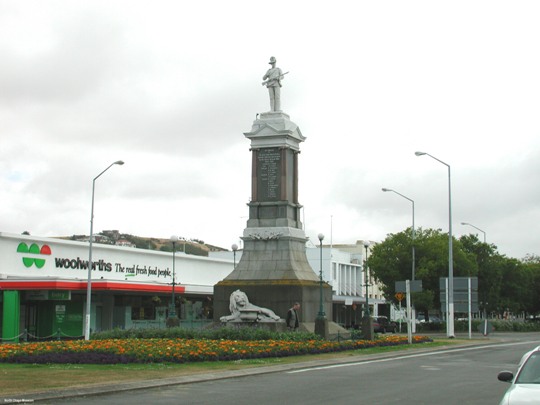The Fallen Troopers’ Memorial stands as ‘an imperishable tribute to the memories’ of North Otago’s sons ‘whose valor ended in their sepulture in a strange and far distant land’ and has historical, architectural and commemorative significance. It was unveiled in Thames Street, Oamaru, by Governor Lord Plunket on 2 February 1905. The South African War (or Second Anglo-Boer War), which began on 12 October 1899, was the first overseas conflict to involve New Zealand troops. The British Empire fought the Boer South African Republic (Transvaal) and their ally, the Orange Free State. New Zealand Premier Richard Seddon was keen to help the Empire, offering to send a contingent of 200 mounted riflemen, a proposal that received wide public support. A hastily assembled force, relying much on volunteer equipment, departed on 21 October 1899. The New Zealanders fought in unfamiliar territory with an opponent who did not follow expected conventions. The British annexed Transvaal in October 1900, marking the second stage of the war: guerilla war. The last engagement New Zealand troops took part in was at Langerwacht Hill on 23 February 1902. A peace treaty was signed on 1 June 1902. New Zealanders were quick to erect memorials to its war dead – the first erected within six months of the troops’ return. Some 43 memorials were erected, expressing loyalty and commitment to the Empire and New Zealand’s place in it. Prominent citizens, leading businessmen and mayors and councilors were the prime movers of war memorials. In Oamaru, local solicitor, climber and explorer, William G. Grave, raised most of the £1,700 needed to build the memorial by cycling around North Otago, extracting donations from virtually every household and claiming just five shillings for expenses. Bergamini and Reid of Dunedin designed the memorial. Supervising architect John Megget Forrester advertised for tenders for the erection of the ‘Fallen Troopers’ Memorial’ on 17 June 1903. Thompson and Co. won the contract with their price of £1,375, but asked to be relieved of the job in December 1903, because they could not complete it within the tendered amount without altering the specifications. Monumental mason John Crombie offered to take up the contract, with some changes, at a cost of £1,300. The committee accepted Crombie’s offer. Thames Street was crowded with people who came to watch the Governor unveil the memorial on 2 February 1905. A band and an infantry guard of honour met the Governor General at the railway station and escorted him to the memorial where mounted troops under Lieutenant Colonel Nichols stood ready to fire a salute. Public School Cadets, Defence Cadets and the Third Battalion of the Otago Volunteer Regiment lined the streets, mingling with the crowds. After the Governor unveiled the monument, the volunteers fired three volleys in the air, bugles sounded the last post, and invited guests attended a garden party. 'Trooper Jack', the soldier atop the monument, is based on North Otago man David Mickle Jack, and was carved by the Italian sculptor Carlo Bergamini. The foundation is concrete, the base is Port Chalmers bluestone, and the rest is granite and marble sourced from Europe. Lamps stand at the corners of the memorial. In 2008 the memorial was dismantled, shifted 40 metres south and turned around 180 degrees to face north as part of a major road realignment to improve traffic safety. The photographs taken in November 2008 showed it nearing the end of that process, with both Trooper Jack and the imperial lion showing the benefits of cleaning and restoration. In 2015, the Fallen Troopers’ Memorial remains a landmark on Thames Street, remembering not only of ‘loyalty and homage’ but also acting as a warning against the ‘grave blunder which resulted in so appalling a sacrifice’ – a ‘sorrowful remembrancer and a mentor’.

Location
List Entry Information
Overview
Detailed List Entry
Status
Listed
List Entry Status
Historic Place Category 2
Access
Able to Visit
List Number
2273
Date Entered
7th July 1982
Date of Effect
7th July 1982
City/District Council
Waitaki District
Region
Otago Region
Extent of List Entry
Extent includes the land described as Legal Road, Otago Land District, and the Fallen Troopers’ Memorial, Oamaru, thereon.
Legal description
Legal Road, Otago Land District
Stay up to date with Heritage this month
